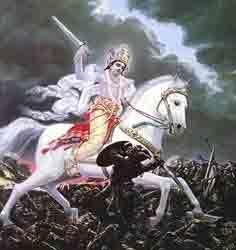 |
| Alauddin Khilji |
The second ruler of the Khilji dynasty of the
famed Delhi Sultanate, Alauddin Khilji was a militarist and imperialist to the
core. He was very ambitious. In a haste to be the Khilji Sultan, he usurped the
throne for himself by killing treacherously his loving uncle and father-in-law
Jalaluddin Firuz Khilji, the founder of the Khilji Dynasty.
It
is natural for a self-willed and ambitious ruler to embark on the path of annexation
of new territories to his kingdom. Alauddin,
whose original name was Ali Gurshap, loved to style himself “the Second
Alexander” (Sikander-i-Sani). As a matter of fact, with the assumption of power
at Delhi begins ‘the imperial phase of the Sultanate’.
Conquest of Gujarat
The
kingdom of Gujarat was then ruled by king Karna Dev of the Vaghelas who were
feudatories of the Solanki Rajput rulers also called Chalukyas. The Gujarat
kingdom was famed for vast fortunes which it acquired from sea-borne trade with
Arabs and Persians. In 1299 Alauddin
send a military expedition to this kingdom under the joint command of his two
ablest generals Ulugh khan and Nusarat Khan, who invaded Anhilwad, the capital
of Gujarat. As Karna Dev Vaghela was not ready for sudden attack, he was caught
unawares and fled to the Yadava kingdom of Devagiri in Northern Deccan with his
daughter Dewal Devi. His chief queen Kamaladevi was taken prisoner by the victorious
army. Kamaladevi later became the favourite wife of Alauddin. A large booty was
accrued to the Khilji’s coffer by the plunder of the rich port of Cambay. However, the prized capture during the Gujarat conquest by Nusarat Khan was Hindu turned
Muslim slave Malik Kafur (also known as hazardinari). Kafur was a eunuch who later on rose to become
Alauddin’s most important military general and the malik naib of the Khilji
dynasty. He led many successful military expeditions of the Khilji ruler in the
coming years.
After
the conquest of the Vaghela kingdom of Gujarat, Alauddin turned his attention to
Rajputana, where he conquered Ranathambhor in 1300-1 from Hamir Deva, a descendant
of Prithviraj Chauhan, who was defeated in the Second Battle of Tarain by
Muhammad Ghori in 1192, resulting in the establishment of Muslim rule in Delhi.
Chittor Conquest
After
the subjugation of Ranathambhor was complete, Alauddin attacked Chittor, the
capital of the powerful kingdom of Mewar, in 1303. Mewar was ruled by the
Guhilot king Rana Ratan Singh. Various Rajput sources and Padmavat by Malik
Muhammad Jayasi say that Alauddin’s invasion of the Rajput kingdom was driven
by his infatuation with the Padmini, the beautiful queen of Rana Ratan Singh. However
this episode served as the casus belli of the Mewar invasion is in the realm of
debate. The opponents of the theory cite example of the legendary royal court
poet Amir Khusro of Delhi Sultanate who makes no mention of the story though he
himself was the part of Alauddin’ entourage during the latter’s Mewar
expedition. Besides, this story is unknown to other contemporary sources. After
a long siege of eight months, success attended the Khilji army in the capture
of Chittor, which was named Khizrabad, after the name of Alauddin’s eldest son
Khizr Khan.
Annexation of Malwa
With
the incorporation of Gujarat, Mewar and Ranathambhor into the Delhi Sultanate, Alauddin
sent a military expedition for the conquest of Malwa under the generalship of
Ain-ul-mulk Multani. Malwa was ruled by Mahlak Dev, who along with his general
Harnanda Koka, were killed in the bloody war that took place between the Sultan
army and the Malwa forces in 1305. Malwa with its centres of power like Dhara, Mandu
and Dhara and Chanderi fell into the hands of the victor and Ain-ul-mulk
Multani was appointed governor of the province.
South Indian Conquests
After
annexation of North India, Alauddin embarked on a military expedition under the
command of Malik Kafur for the subjugation of South India. There were four
major kingdoms ruling South India at the time. These were Yadava dynasty of
Devagiri, Kakatiya kingdom of Warangal, the Hoyasala dynasty of Dwarasamudra
and Pandyas of Madurai. Malik Kafur defeated the Yadava King Ramchandra in
1307, the Kakatiya King Pratap Rudra Deva II in 1309-10 and the Hoyasala King
Vira Ballal III in 1311. But Kafur’s invasion of the Pandyan kingdom remained
inclusive as Vira Pandya and Sundara Padya, the claimants to the Pandyan
throne, refused to acknowledge the suzerainty of the Delhi Sultanate. In 1313,
after the death of the Yadava ruler Ramchandra, when his son Singhana III declared
his independence, Malik Kafur again marched towards Devagiri and annexed it to
the Khilji kingdom.




